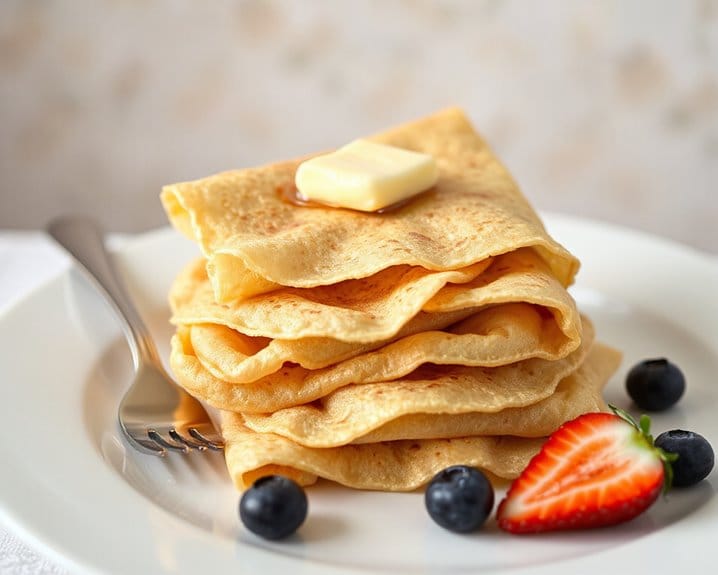Why You’ll Love these Classic French Crepes
Whether you’re a seasoned chef or a kitchen novice, these classic French crepes are about to become your new obsession. I’m talking about delicate, paper-thin pancakes that practically melt in your mouth, yet are surprisingly simple to master.
What makes Nadine’s recipe special? It’s the perfect balance of milk, flour, and egg that creates that signature tender texture. Unlike thicker American pancakes, these crepes develop beautiful lacy edges and a subtle golden hue that signals perfection.
Can you imagine the versatility? From savory fillings with roast beef and cheese to sweet treats drizzled with honey, these crepes transform any meal. The best part? You’ll look like a culinary wizard with minimal effort. Who doesn’t want that kitchen superpower?
What Ingredients are in Classic French Crepes?
Nadine’s classic French crepe recipe is truly a marvel of simplicity and elegance. The beauty of crepes lies in their versatility—they can be filled with sweet or savory ingredients, served as breakfast, lunch, dinner, or dessert. For this particular recipe, we’re focusing on the traditional French-style crepe base that serves as the perfect canvas for whatever fillings your heart desires.
When shopping for these ingredients, quality matters but doesn’t need to break the bank. Room temperature eggs blend more easily with the batter, and whole milk creates a richer flavor than reduced-fat alternatives. The butter should be unsalted if possible, giving you more control over the final taste. Don’t worry about having special equipment—while a crepe pan is nice, any non-stick skillet will work beautifully for creating these thin, delicate pancakes.
- 2 cups milk
- 2 cups flour
- 1 egg
- 3 teaspoons butter (for cooking the crepes)
How to Make these Classic French Crepes

Making Nadine’s classic crepes starts with a simple batter that yields tender, delicate results. In a mixing bowl, combine 2 cups of milk, 2 cups of flour, and 1 egg, whisking until smooth and lump-free. The consistency should be quite thin—much thinner than pancake batter—allowing it to spread beautifully across the pan. If your mixture seems too thick, don’t hesitate to add a splash more milk to reach that perfect pourable consistency.
Heat your pan over medium heat, then add a small portion (about 1/4 teaspoon) of the 3 teaspoons of butter called for in the recipe. Once melted and slightly bubbling, pour in a small amount of batter—just about the size of an espresso cup or a quarter of a regular measuring cup. Quickly tilt and swirl the pan to spread the batter into a thin, even layer. Watch as the edges begin to curl slightly, waiting for that light golden-brown color to develop before gently flipping with a thin spatula. The second side needs less time, maybe 30 seconds or so, just enough to set and color slightly. Remove your crepe to a plate and repeat the process, adding that small bit of butter before each new crepe.
The trick with crepes? Patience and timing. Too hot a pan, and they’ll brown before cooking through; too cool, and they’ll be tough rather than tender. For professional-quality results, consider investing in a high-end crepe maker that provides consistent temperature control for perfectly thin, evenly cooked crepes every time.
Classic French Crepes Substitutions and Variations
Three wonderful variations can transform these classic French crepes into entirely different dining experiences. First, try swapping the parmesan for gruyère and the roast beef for ham—you’ll get a more traditional French flavor profile that’s absolutely divine with a glass of white wine.
For a vegetarian option, I’d recommend replacing the beef with sautéed mushrooms and spinach. The earthiness pairs beautifully with the cheese sauce, and you won’t miss the meat, trust me.
Feeling adventurous? Go sweet instead of savory by omitting the cheese sauce altogether. Fill the crepes with Nutella, sliced bananas, and a sprinkle of powdered sugar. Or maybe fresh berries and whipped cream? The basic crepe batter works perfectly for both savory and sweet applications.
What to Serve with Classic French Crepes
What could possibly enhance the perfect French crepe experience? Honestly, the filling options are endless, but let me share some favorites that complement Nadine’s recipe beautifully.
For savory crepes, I’m obsessed with pairing them with a crisp green salad dressed in a light vinaigrette. The acidity cuts through the richness of that parmesan and mozzarella filling, creating flavor harmony you’ll dream about. A chilled glass of white wine doesn’t hurt either.
Sweet crepes? Try fresh berries with a dollop of whipped cream, or go decadent with Nutella and sliced bananas. For breakfast, I’d suggest freshly squeezed orange juice and strong coffee—the bitter-sweet combination with a sweet crepe is absolutely divine.
Final Thoughts
While mastering the art of French crepes might seem intimidating at first, Nadine’s recipe truly brings this classic into reach for home cooks of all skill levels. The simple combination of milk, flour, and egg transforms into delicate, paper-thin pancakes that can cradle both sweet and savory fillings.
I’m particularly fond of how versatile these crepes are. Breakfast, lunch, dinner, dessert—they work for any occasion. Can you think of many other dishes with that kind of range? The roast beef filling with that cheesy sauce adds such a wonderful dimension to what might otherwise be considered just a breakfast food.

